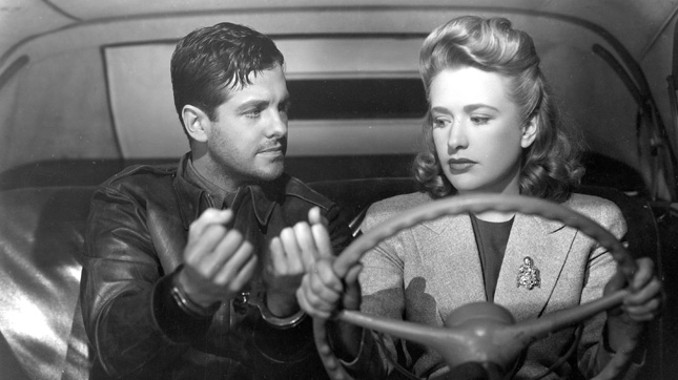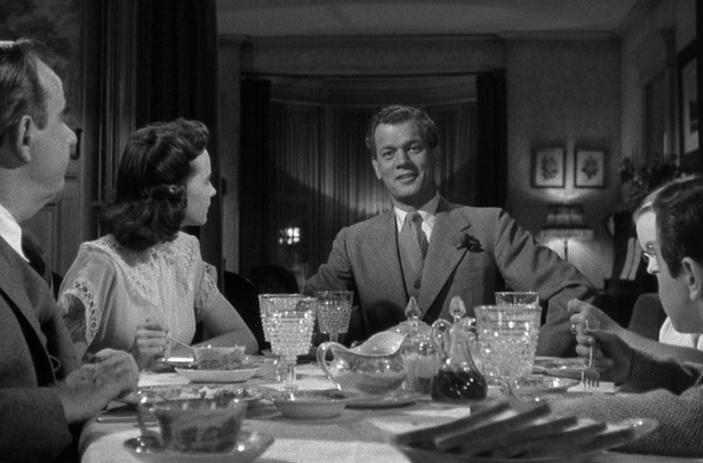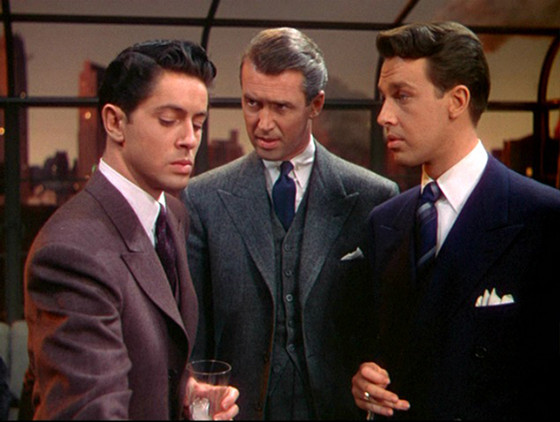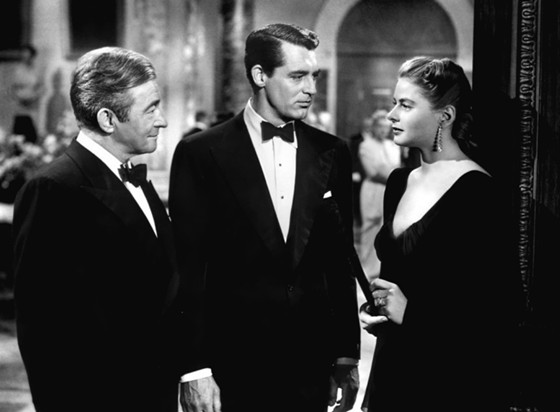4. Saboteur (1942)

Saboteur was another loan out for Hitchcock (apparently Selznik rejected the script), this time to Universal, and whilst it might appear on the surface to be a simple adventure filled romp (an enjoyable one too) there is in fact a bit more to it.
The basic concept is pure Hitchcock; an innocent man being accused of, and pursued for, a crime that he did not commit, whilst simultaneously pursuing the real culprits responsible.
This is more than a nod back to his English films, but an extension and politicisation of it; here Hitchcock makes another plea to the U.S government to intervene in the war in Europe by showing them that no matter what they do, the corrupting influence of the Nazi’s will undoubtedly reach as far as their country sooner or later.
In spite of its political agenda, the film still presents a wonderful, exciting romp from California to New York that culminates in a dramatic showdown atop the Statue of Liberty, and a parody of the spy thriller; engaging, amusing and thrilling in equal measure, it is designed to keep audiences upon the edge of their collective seat – which it managed with aplomb.
In it, Barry Kane (Robert Cummings) finds himself being accused of starting a fire at the aircraft manufacturer where he works, an event that claimed the life of his friend Mason. In his attempts to battle the raging fire, he was handed a fire extinguisher filled with petrol by a man named Frank Fry (Norman Lloyd), whom he believes to be the real culprit.
Fry, of course, is not an employee of the company, so Kane’s guilt is accepted. He leaves and attempts to track down the real saboteur, trailing him across the country, befriending a blind man and his niece, Patricia (Priscilla Lane), who tries to hand him over to the police until he convinces her of his innocence.
En route to New York, the two of them foil a plot to destroy Boulder Dam before ending up at a glitzy, high society social gathering where the conspirators are gathering prior the film’s climactic sequence where Kane and Fry engage in a tense confrontation.
The social gathering, and the scene with the ranch owner (Otto Kruger), are quite important in establishing a recognisable trait in Hitchcock’s work; the respectable face of evil. In this case the fascists that are seeking to sabotage the country’s ability to enter into the war are wealthy, well liked and seemingly reputable members of the American upper classes – much like the antagonists of his later effort, North by Northwest.
There are other aspects of the film that perhaps deserve more credit too, it’s impressive mixture of matte work with real footage is worthy of a mention, whilst some of the innovations used to create its most noteworthy sequences are simply brilliant.
The scene in Radio City where Fry is pursued into a theatre utilised the actions and audio from what was displayed on screen to replicate what was happening inside the theatre itself, with gunshots perfectly synchronised, or the use of the song “Who Killed Cock Robin?” to intensify the grief that a character is feeling after the death of a sibling.
Most fascinating would be the fall that Fry takes at the finale, which was filmed from above as he lay on a black background before real footage taken from the Statue of Liberty was later overlaid, making it a very early precursor to the modern green screen.
Additionally, there is a hint of social commentary from Hitchcock, for during Kane’s cross-country adventure, the only people that perceive his innocence and assist him in his quest are the poorer residents that he encounters, whilst the rich are either members of the right-wing saboteurs or are funding them.
Also, it must be noted that the final confrontation takes place in the Statue of Liberty for a definite, very purposeful reason; it insinuates that spies hide beneath the protective mantle of freedom.
3. Shadow of a Doubt (1943)

From his rather extensive oeuvre, this was actually the favourite film of Alfred Hitchcock himself, it is based on a story penned by Gordon McDonnell and adapted for the screen by the future Academy Award nominee, Sally Benson, and the playwright and novelist Thornton Wilder (this being the only screenplay that he worked on).
After the enormous commercial success of Saboteur, producer Jack Skirball proposed that Hitch have free reign to make a film of his own choosing, which is presumably why it became such a personal project for him with numerous autobiographical elements making it into the movie (Uncle Charlie’s sister, the mother of the household is named Emma – the same as Hitch’s own mum).
The results, are most assuredly impressive, almost to the extent that they couldn’t have been bettered. However, the supporting cast of characters are a tad weak and in need of supplementary development, but this is countered expertly by the film’s use of the everyday to heighten the tension and the depravity of the killer’s actions.
The setting was of great importance to Hitchcock, which is why the exterior shots are all filmed on location within a leafy suburban setting in California as opposed to a studio backlot – though some sets were created, including replicas of the house that the family live in.
The story concerns Joseph Cotton’s Charlie Oakley, a man who supports himself financially by wooing and killing wealthy widows, earning him the moniker of the Merry Widow Murderer. When the police begin to suspect him of these heinous crimes, he flees to Santa Rosa to take refuge with his sister and her family who welcome him into their home with open arms.
His niece, also called Charlie (played by Teresa Wright) is a bored teenager who looks up to her uncle, idolises him in fact, and yet it is she who, slowly but surely, begins to suspect that he may the man that the police are looking for.
The seeds of which are planted by a young police officer named Jack Graham (MacDonald Carey) who tells her that her uncle is one of two suspects that the police believe to be the killer. Uncle Charlie isn’t quite as cool as a cucumber, letting slip his hatred for rich widows in a conversation with the family’s murder obsessed neighbour, Herbie Hawkins (Hume Croyn), and gifting his niece a ring emblazoned with the initials of one of his victims.
By the time that the authorities wrongly attribute blame to another party (he dies as he attempts to evade police capture), young Charlie has learned the truth and her uncle makes two attempts on her life, before he, during his third and final effort – upon the train that he plans to leave the town on – finally dies himself.
The two principal characters have more in common than a shared name, of course, the complexity of their relationship is alluded to throughout the film, giving an indication that they share such a bond that they even know what each other are thinking at any given time.
The two Charlies are polar opposites of one another; with Uncle Charlie being the antithesis of the young woman’s purity. They can perhaps be seen as two halves of the same whole, and looking at it this way, the two together would form something akin to the split personalities found within Robert Louis Stevenson’s famous gothic creation, The Strange Case of Dr Jekyll and Mr Hyde.
A prime example of the connection between them occurs right at the start of the film as we see Joseph Cotton (in Philadelphia) lying about considering a visit to his sister’s family, in this shot he is at full stretch on the right-hand side of the bed.
Hitchcock then cuts to a shot of Teresa Wright who is hopeful that something might happen to breathe life into her dreary little town, she is in a markedly similar pose, stretched out down the left side of her own bed. They form mirror images of one another and share the same thought; Uncle Charlie should visit Santa Rosa.
Hitchcock is quite famous for utilising a transference of guilt within his narrative structures, but in Shadow of a Doubt we witness something else. As it was Uncle Charlie’s accident that took away his own innocence, so is it that his actions deprive his niece of hers in turn.
During his funeral at the end of the film, the young woman – now fully transformed from the girl we see at the start – ponders why such men can exist in the world and in doing so comes to recognise a darkness beyond the superficial, quaint veil of her native Santa Rosa, ensuring that nothing will ever be the same for her again.
2. Rope (1948)

The first picture that Hitchcock made as part of his Trans-Atlantic Pictures production company, it was intended to be Under Capricorn (a project close to his heart), but he instead wanted to create something a tad more low-key, something that required only a limited budget to act as a test run for it, but that’s not to say that it wasn’t ambitious – for most director’s it would have been overly so.
Its technical demands stem primarily from the fact that its director desired to replicate the experience of a theatre production, something that would appear to flow entirely in real-time, but there is one clear cut in the film.
Technically, there are many more, it was shot in takes that utilised anything up to the full ten minutes of film that could be held in the cameras (three hundred metres worth), with continuity maintained by close ups and tracking shots that typically closed in on pieces of furniture or the backs of characters to obscure our field of view.
The use of such long takes actually benefitted the production in another area too; its budget. Doing so decreased the costs involved and reduced the total amount of shooting time needed to just eighteen days, and as if these feats along weren’t already impressive enough, it also just happens to be something of a masterpiece of filmmaking too.
Rope tells the story of two homosexual killers, Brandon and Philip (played by John Dall and Farley Granger respectively) who, believing themselves to be superior creatures, murder their friend David (Dick Hogan) and hide his body within their apartment before throwing a lavish cocktail party. They feel that their work is art, and that the party will elevate this to the ranking of a masterpiece, thereby confirming their intellectual superiority.
The party’s guest list includes the murdered man’s girlfriend, as well as his parents, and the killers’ former mentor, Rupert Cadell (James Stewart). Cadell is an author of intellectual publications, and during the party he outlines his belief to the partygoers that the Übermensch (or overman) should be able to kill their inferiors if they so desire. Having seen the heinous actions of his former pupils, however, he soon realises this to be incorrect.
Owing to censorship issues at the time regarding homosexuality, the nature of the relationship between Brandon and Philip is tricky to perceive, though there is a definite power balance between the two with one dominating the other.
The murder, whilst in their eyes is an act of perfection because there is no perceivable motive, was intended by Hitchcock to be seen as an act of repressed sexuality; it is quite possible that they chose David as their victim on the basis of his heterosexuality, which could indicate a rejection of them on his part. What’s undoubtedly clear cut though, are the philosophical and political angles imbued into the narrative.
Rope is undoubtedly another anti-Nazi film that incorporates the same misinterpretation of Friedrich Nietzche’s theory of the Übermensch as an excuse for murder, except that here it is shown to be false. The film’s title (though it was based on a 1929 play) is surely derived from Also Sprach Zarathustra wherein the philosopher wrote that “man is a rope, fastened between animal and Übermensch – a rope over an abyss”.
Transference of guilt, taken from Catholicism first and the French play Nos Deux Conscience later, is something that fascinated Hitchcock and here, in Rope, we have a fine showing for the concept as James Stewart’s Rupert shoulders the blame for what his young wards have become.
Aroused by suspicion, he returns to the apartment after the rest of the guests have departed under the guise of having left his cigarette case there, and with a drunken Philip coming to pieces, discovers David’s body.
Seeing his old rhetoric turned back against him, he abandons it, wrestles a gun away from Brandon and fires off a few rounds in order to alert the police. As they approach the building, Rupert takes a seat next to the body highlighting his acceptance of his share of the guilt.
It’s interesting that only a decade prior to the creation of Rope, Hitchcock was a vocal opponent of using long takes and here he embraces them wholeheartedly, one could argue that he was already a master of cinematic technique and that he was merely looking for a means through which to challenge himself.
Yet he was evidently looking to create something new, a pure experience where the viewer would be trapped in the same room as, and participate in a murder, and this he managed to pull off exceptionally well.
It is a technical masterpiece, whether it’s the use of lighting to show the changing time of day (to provide the feeling of real time), the fleeting glimpses that we get of what’s happening in other rooms or the brilliant light system employed to give actors their cues.
Certainly, there are elements of the story that haven’t translated particularly well thanks to the censors, but putting that aside, Rope is a brilliant piece of film making; politically and philosophically motivated, brilliantly acted and perfectly executed.
1. Notorious (1946)

Made on loan at RKO (who seemingly barred David O. Selznik from the set), Notorious is the second of the three films that the director would make with Ingrid Bergman, and continuing on from Spellbound, her performance is stellar; her character insecure and wracked with guilt, she finds hope for the possibility of redemption in her love for her opposite number, Cary Grant.
It wasn’t the only continuing theme for Bergman though, in 1938 she starred in a rather famous love story set against the backdrop of war, and that is precisely what’s also happening here, though admittedly that’s where the similarities between Notorious and Casablanca conclude too.
In its simplest form, the plot for Notorious is a basic spy story in which Grant’s T.R. Devlin recruits Bergman’s Alicia Huberman – the American born daughter of a Nazi spy – to snoop on a friend of her father’s, Alexander Sebastian, a Nazi who has fled to South America (played by Claude Rains).
Alicia is a woman caught between two opposing worlds, who has sought only to escape her troubles in alcoholism and sexual escapades, and this feeling of not knowing where she stands is carried on as the film focuses upon the love triangle that is developed between these three characters.
Devlin and Alicia fall in love by the time she arrives in Rio to seduce Sebastian in the interests of national security, with the smitten Nazi ultimately proposing to, and wedding her. He soon discovers that she is a spy and begins to poison her with ever increasing doses of arsenic, though this is stopped just prior to him killing her.
It could be argued that he is the one that truly loves her, forfeiting his own life in the end so that she might live (the simple, but elegant finale), his sacrifice made all the more heart rending by Grant’s stony faced, seemingly uncaring performance.
In truth, whilst we see a coldness to Cary Grant’s on-screen persona, he is very much in love with Alicia and she him, yet they do not understand one another, and it is this that leads to a breakdown in communication between them.
They each presume the actions of the other and are deflated when their assumed behaviours are not acted out; Alicia’s acceptance of the assignment to woo Sebastian, along with her decision to marry him are prime examples of this, she expected Devlin to intervene whilst he presumed that she would refuse.
Inaction as indifference, cold and uncaring, yet this only represents what is on the surface. Underneath, however, it is a film full of sensuality, redemption and love, which is probably why Francois Truffaut regarded it so highly.
There is obviously a political undercurrent to the film that again associates the Nazis with evil doers, but as with almost every other film of Hitch’s, he doesn’t keep things that simple.
Whilst yes, they are behind a debauched, Machiavellian plot for revenge in the wake of their defeat in the war, but their representatives are not two-dimensional comic book caricatures, but rather developed, rounded creations with Sebastian being the cream of the crop.
There is a distinct possibility that the character is something of a reference to St. Sebastian, a man who would rather die than renounce that which he believes, but then there are also a couple of autobiographical elements that Hitchcock has imbued him with; the first being his captivation with a younger woman, mirroring the director’s own fascination with his leading lady and the subsequent actresses that would replace her.
Secondly, he has an overbearing, domineering mother that exerts control over him, something that would become a recurring theme for Hitch, most notably used, of course, in Psycho.
Hitchcock wanted what he called a MacGuffin (an important plot point with little explanation) for this picture and settled upon weapons grade uranium, something that Selznik – who was first offered the script – couldn’t quite understand.
Hitch met with experts in the field who all fed him red herrings to lure him elsewhere, and worried by the accuracy of his plot point, the FBI followed the director for several months in an effort to determine where the information had come from – the writing of the script had occurred a year before the Hiroshima bomb was dropped, so such knowledge was not as widespread as it is now.
It is criminal that the film was not recognised with any Oscar wins, though it did receive two nominations for Best Supporting Actor (Claude Rains was magnificent as Sebastian, a miracle considering he had to stand on platforms to match Bergman’s physical presence) and Best Original Screenplay (Ben Hecht), it was also the Official Selection of the Cannes Film Festival that year.
Thirty-three years later in 1979, the American Film Institute awarded Hitch a Lifetime Achievement Award in recognition of his services to the seventh art, that of motion pictures. At the dinner there, Ingrid Bergman presented to him the prop cellar key from the film. And like that prop, Notorious, the film, is incredibly difficult to let go of; it is a watershed moment for its director and undoubtedly one of the finest films ever created.